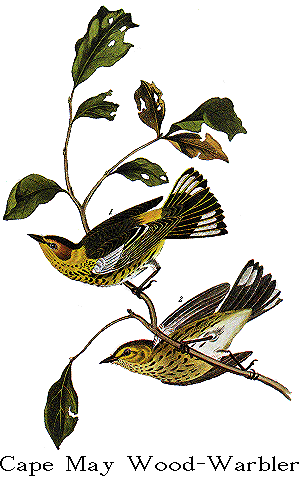Birds of America
By John James Audubon, F. R. SS. L. & E.
VOLUME II.



Family
Genus

CAPE MAY WOOD-WARBLER.
[Cape May Warbler.]
SYLVICOLA MARITINA, Wils.
[Dendroica tigrina.]

PLATE LXXXV.--MALE AND FEMALE.
Of this beautiful species, which was first described by WILSON, very little
is known. It seems to pass rapidly through our Middle Districts in May. I have
never met with a single bird of this kind on my rambles, and am indebted for the
fine specimens of both sexes in my possession, and from which I drew the figures
in the plate, to my generous friend EDWARD HARRIS, Esq. of Moorestown, New
Jersey, who procured them, with several others, in that district.
CAPE MAY WARBLER, Sylvia maritima, Wils. Amer. Orn., vol. iv. p. 99.
SYLVIA MARITIMA, Bonap. Syn., p. 79.
CAPE MAY WARBLER, Sylvia maritima, Nutt. Man., vol. i. p. 156.
CAPE MAY WARBLER, Sylvia maritima, Aud. Orn. Biog., vol. v. p. 156.
Wings pointed, first quill longest, the second a quarter of a twelfth
shorter, the third a twelfth shorter; tail slightly emarginate. Male with the
upper part of the head and fore part of the back yellowish-olive, streaked with
black; the rump, throat, and a collar scarcely meeting behind, yellow;
ear-coverts and a band over the eye yellowish-red, loral space paler; a white
patch on the wing, formed by the first row of small coverts and the outer edges
of the secondary coverts; quills and tail-feathers blackish-brown, edged with
dull greyish-white, the secondaries more broadly; tail-feathers edged with
yellow at the base, the outer three with a white patch on the inner web near the
end; lower parts yellow, streaked with black, abdomen and lower tail-coverts
white, the latter tinged with yellow. Female similar to the male, with the
tints duller, the dusky streaks on the upper parts very faint, the rump
greenish-yellow, the car-coverts dull yellow, the white of the abdomen more
extended, and the black streaks on the breast less distinct.
Male, 5 1/2, 8 1/2.
New Jersey, and Blue Mountains of Vermont. Exceedingly rare.









